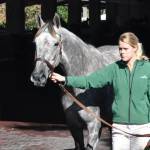Research Supports Heritability of Racing Ability

Is there a specific “speed gene” in Thoroughbred horses? While it could be argued that centuries of selective breeding for speed have made this question superfluous, no one will deny that some horses are sprinters (fast over a short distance) and others are stayers (known for stamina over longer distances). Still other horses, unfortunately, don’t seem to excel at any distance. Factors such as dam’s status in the herd (foals of dominant mares seem to race more successfully than foals of timid mares) have been advanced to explain racing prowess, and certainly nutritional status, training method, and level of physical maturity are important influences on a young horse’s ability to run.
In two separate studies, the myostatin gene, located on chromosome 18, has been identified as an important indicator of athletic ability in Thoroughbreds. A particular mutation of this gene increases muscle mass, theoretically allowing horses with the mutation to achieve superior performance. In tests to analyze the DNA of almost 150 Thoroughbreds, researchers at University College Dublin produced data that indicated whether a particular horse would be most likely to succeed in short, medium, or longer races.
Emmeline Hill, leader of the Dublin research team, explained the importance of the recent findings. She commented, “The ongoing, rapid developments in genomic technology are facilitating the identification of the key genetic variants that contribute to the athletic phenotype (physical characteristics).”
Similar research conducted in Japan found that the characteristics of the area near the myostatin gene also had an important influence on a horse’s athletic ability. In this study, statistics compiled by the Japan Racing Association as to each horse’s performance ranking and lifetime earnings were examined. Three genetic markers on chromosome 18 were found to be correlated with performance, supporting the theory that racing ability is a heritable trait.
Looking to the not-too-distant future, genetic testing of mares and stallions could reveal information about the best breeding choices to produce winning offspring. Testing of young horses would allow owners to determine each horse’s trend toward speed and maturation rate. With this information, managers and trainers could make more educated decisions as to whether each yearling should be pointed toward two-year-old races or allowed to mature further before starting its racing careers.








